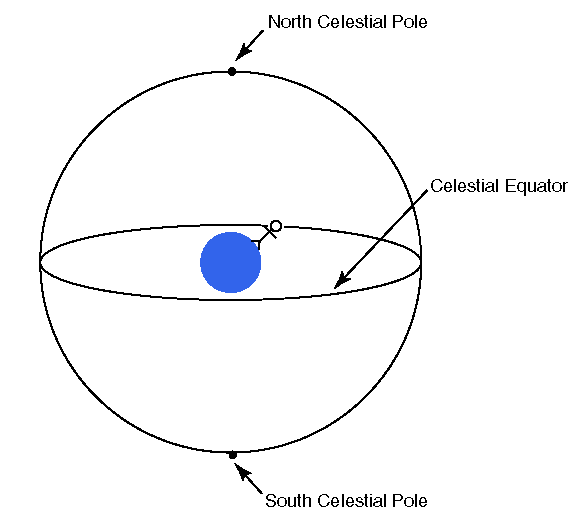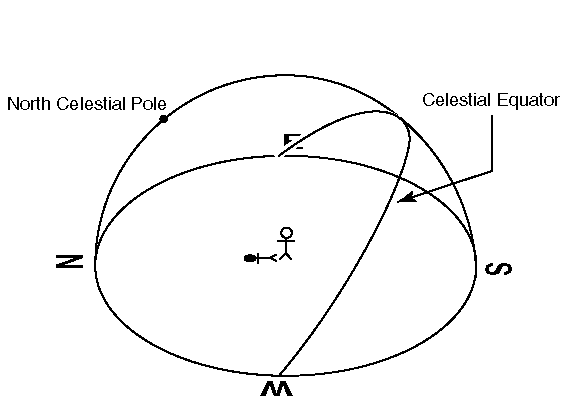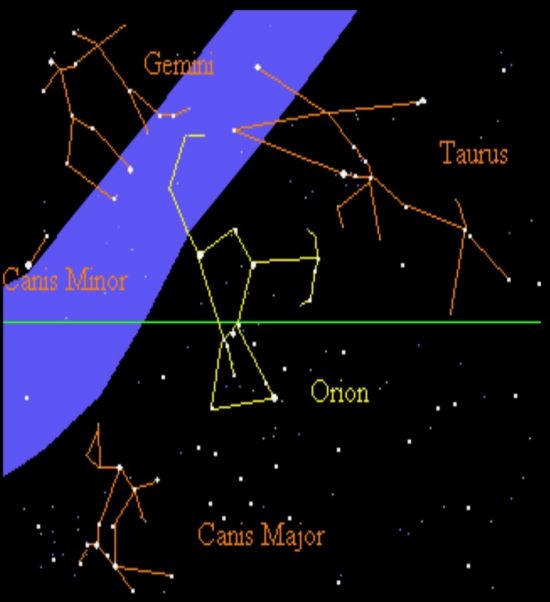
In late November, from around the world, the constellation Orion rises into your eastern sky around 9 p.m. Orion climbs highest up for the night around 1 to 2 a.m. local time (the time on your clock no matter where you are on the globe), and the giant hunter sits low in your western sky around 5 to 6 a.m. Notice the three stars at the mid-section of Orion. We know these stars as Orion’s Belt, but the Aymara people of Bolivia, Peru and Chile call them the Celestial Bridge.
To the Aymara, the Celestial Bridge links the sky’s Northern and Southern Hemispheres. And there’s good reason for that.
We know the westernmost star of the Belt – or Bridge – as Mintaka. This star is special because it sits almost directly astride the celestial equator – the projection of Earth’s equator onto the stellar sphere.
EarthSky lunar calendars are cool! They make great gifts. Order now. Going fast!

The celestial equator is an imaginary great circle on the dome of Earth’s sky, drawn directly above the equator of the Earth. Image via Physics.csbsju.edu.

How you see the celestial equator in your sky depends on your latitude. But, because it’s above Earth’s equator, no matter where you are on the globe, the celestial equator intersects your horizon at points due east and due west. Image via Physics.csbsju.edu.
Its location on the celestial equator makes Mintaka a good guidepost for finding directions here on Earth. That is, Mintaka and the other stars of the Celestial Bridge are visible worldwide. From all over the world, Mintaka rises due east and sets due west, and remains in the sky for 12 hours.
Mintaka climbs to its highest point in the sky midway between rising and setting. If, at this time, this star shines at your zenith (your straight-overhead point), then you must be at the equator. If this star shines in the southern half of your sky, then you must be north of the equator. From most of South America, the star Mintaka appears in the northern sky, telling the Aymara and other sky watchers who know this star that they’re south of the equator.
From the Arctic north to the Antarctic south, the heavenly Celestial Bridge marks the Earthly wayfarer’s way to the equator – the meeting place of the northern and southern skies.

The constellation Orion straddles the celestial equator, which is indicated by a green line on this chart. Since the celestial equator intersects horizons all over the world at points due east and due west (as shown on the chart above this one), the star Mintaka – the one directly on the green line – can be used to find those cardinal directions in your sky. Image via Aloha.net.
Bottom line: To the Aymara – indigenous people in the Andes and Altiplano regions of South America – the famous sky feature we know as Orion’s Belt is seen as a Celestial Bridge between the sky’s Northern and Southern Hemispheres. The westernmost star in the Belt, or Celestial Bridge – a star called Mintaka – lies directly on the celestial equator.
from EarthSky https://ift.tt/2EvXZIL

In late November, from around the world, the constellation Orion rises into your eastern sky around 9 p.m. Orion climbs highest up for the night around 1 to 2 a.m. local time (the time on your clock no matter where you are on the globe), and the giant hunter sits low in your western sky around 5 to 6 a.m. Notice the three stars at the mid-section of Orion. We know these stars as Orion’s Belt, but the Aymara people of Bolivia, Peru and Chile call them the Celestial Bridge.
To the Aymara, the Celestial Bridge links the sky’s Northern and Southern Hemispheres. And there’s good reason for that.
We know the westernmost star of the Belt – or Bridge – as Mintaka. This star is special because it sits almost directly astride the celestial equator – the projection of Earth’s equator onto the stellar sphere.
EarthSky lunar calendars are cool! They make great gifts. Order now. Going fast!

The celestial equator is an imaginary great circle on the dome of Earth’s sky, drawn directly above the equator of the Earth. Image via Physics.csbsju.edu.

How you see the celestial equator in your sky depends on your latitude. But, because it’s above Earth’s equator, no matter where you are on the globe, the celestial equator intersects your horizon at points due east and due west. Image via Physics.csbsju.edu.
Its location on the celestial equator makes Mintaka a good guidepost for finding directions here on Earth. That is, Mintaka and the other stars of the Celestial Bridge are visible worldwide. From all over the world, Mintaka rises due east and sets due west, and remains in the sky for 12 hours.
Mintaka climbs to its highest point in the sky midway between rising and setting. If, at this time, this star shines at your zenith (your straight-overhead point), then you must be at the equator. If this star shines in the southern half of your sky, then you must be north of the equator. From most of South America, the star Mintaka appears in the northern sky, telling the Aymara and other sky watchers who know this star that they’re south of the equator.
From the Arctic north to the Antarctic south, the heavenly Celestial Bridge marks the Earthly wayfarer’s way to the equator – the meeting place of the northern and southern skies.

The constellation Orion straddles the celestial equator, which is indicated by a green line on this chart. Since the celestial equator intersects horizons all over the world at points due east and due west (as shown on the chart above this one), the star Mintaka – the one directly on the green line – can be used to find those cardinal directions in your sky. Image via Aloha.net.
Bottom line: To the Aymara – indigenous people in the Andes and Altiplano regions of South America – the famous sky feature we know as Orion’s Belt is seen as a Celestial Bridge between the sky’s Northern and Southern Hemispheres. The westernmost star in the Belt, or Celestial Bridge – a star called Mintaka – lies directly on the celestial equator.
from EarthSky https://ift.tt/2EvXZIL

Aucun commentaire:
Enregistrer un commentaire